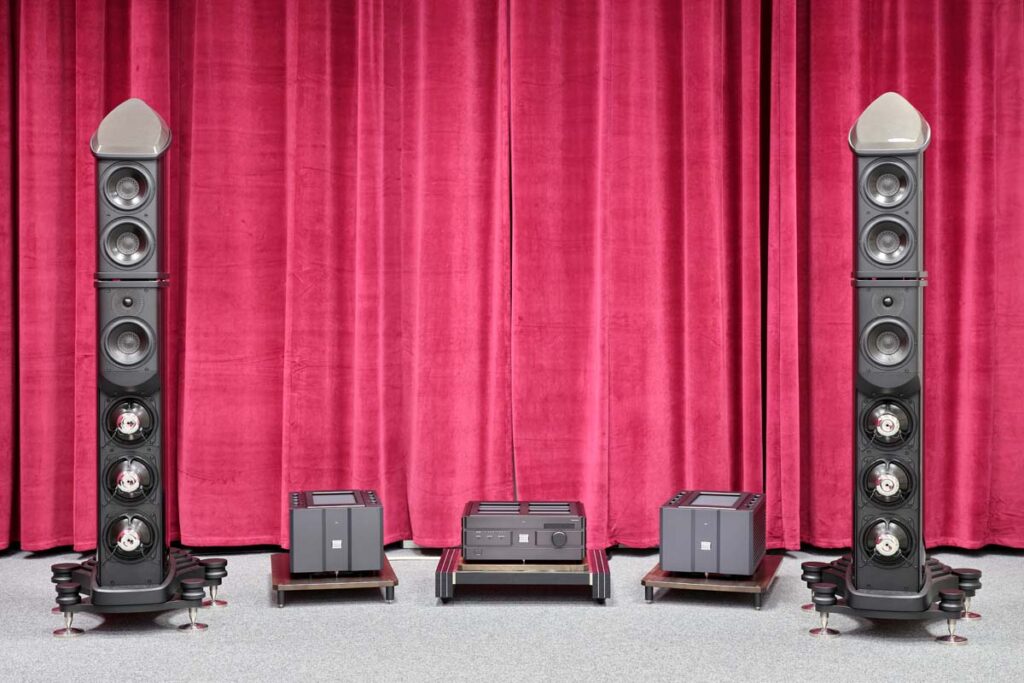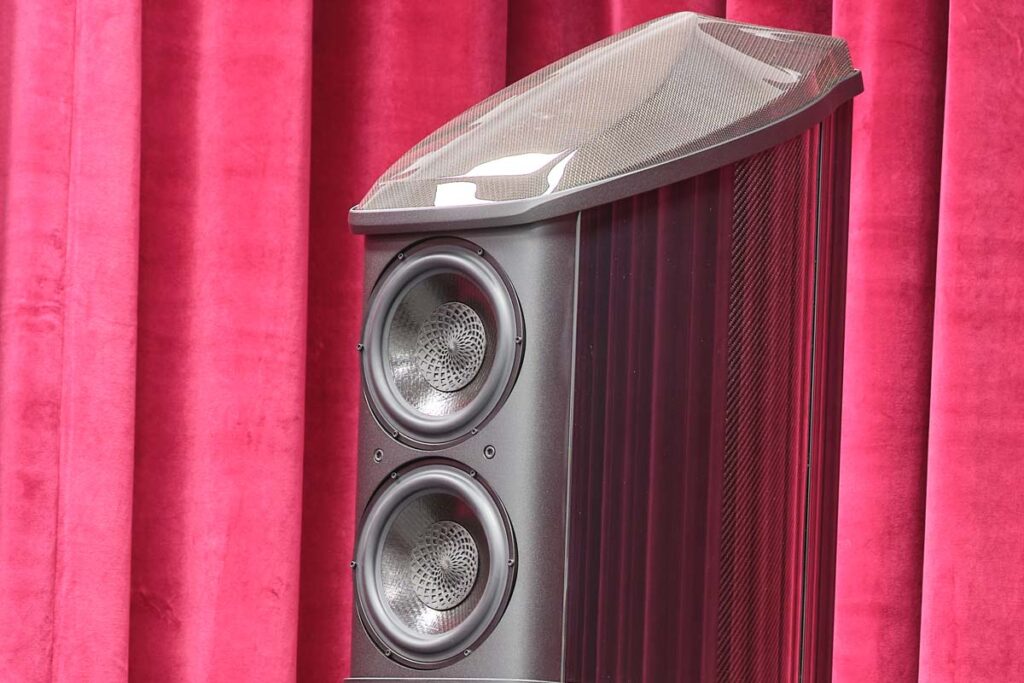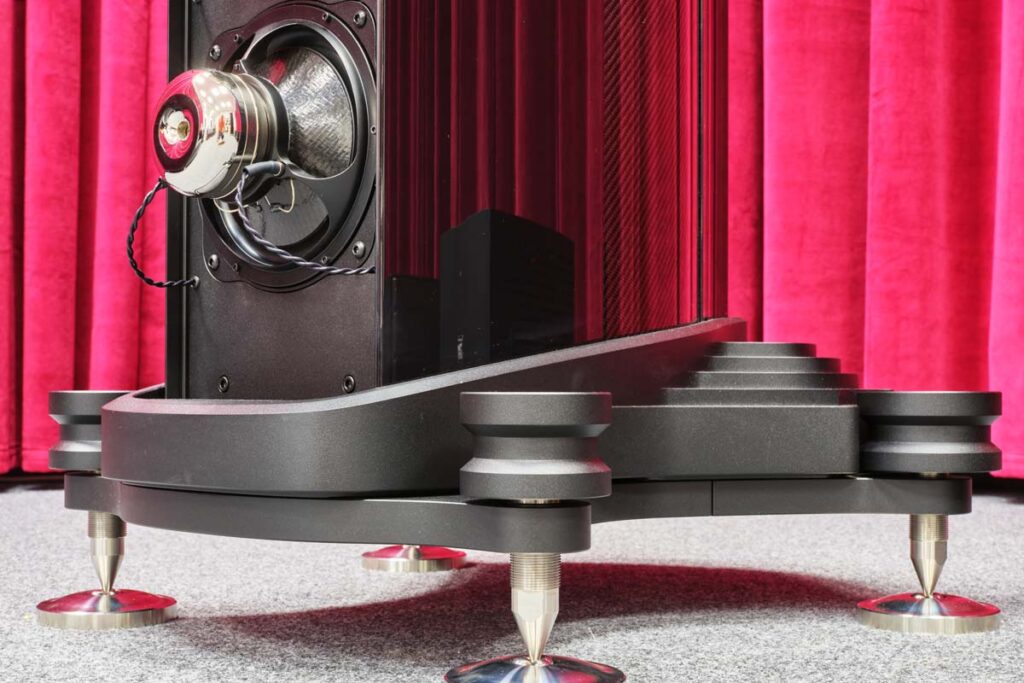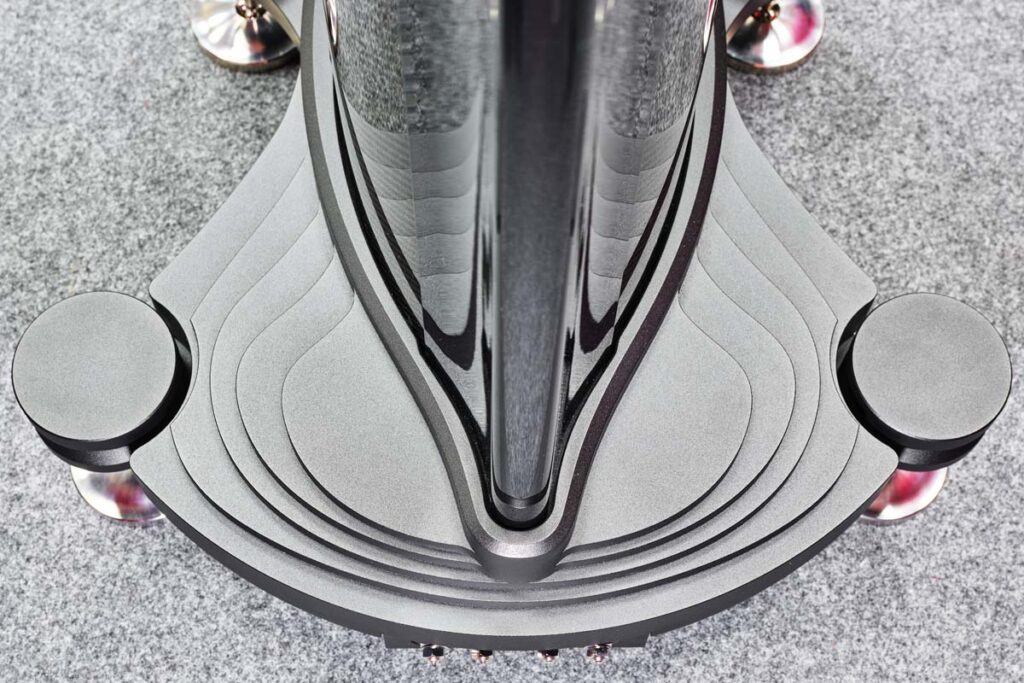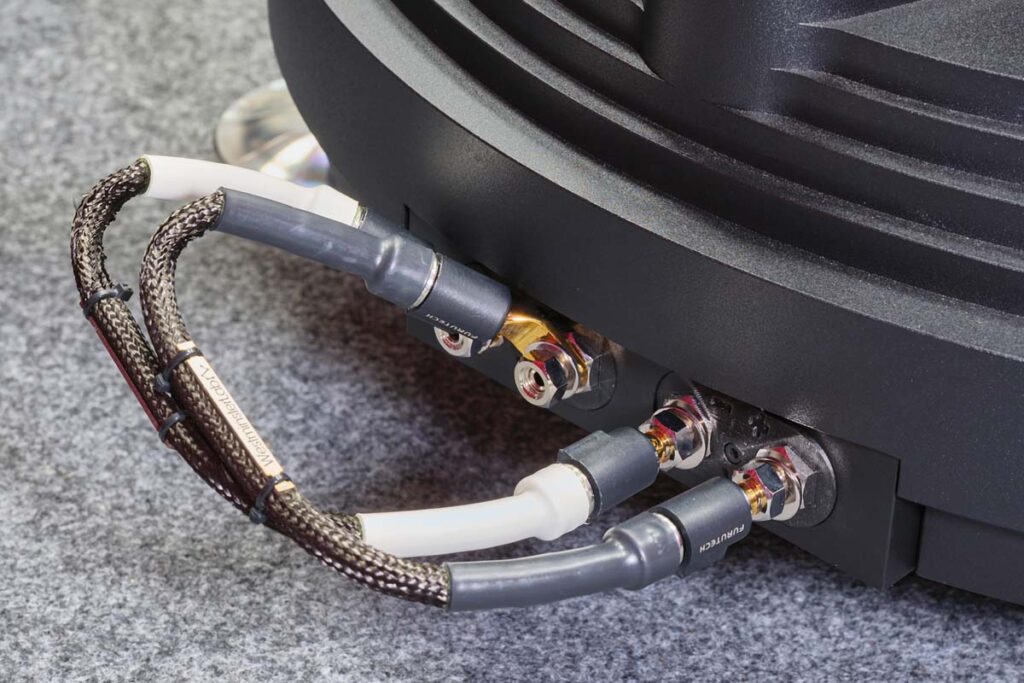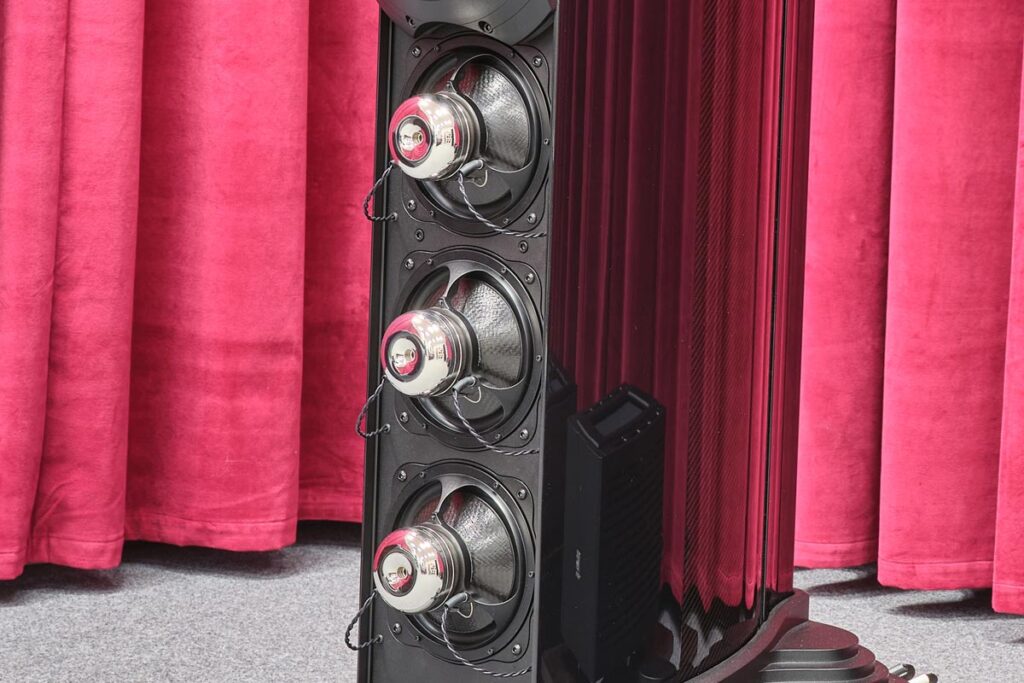I clearly need to work on my vocabulary. The Wilson Benesch Omnium belongs to a new generation (and class) of loudspeakers that can be technically described with well-worn terms like “wide bandwidth,” “high resolution,” “dynamic,” or “well structured” – but none of those come close to characterizing them satisfactorily. What do I mean by that? Grab a cookie, lean back – we’ll try to explain.
Taking delivery of these man-sized giants is sweaty work. Each Wilson Benesch Omnium weighs 140 kilograms (308 pounds), split across two enclosures that, assembled, stand 170 centimeters (5’7″) tall. Wilson Benesch brought the speakers to us straight from the High End Show, where they had just survived – and enjoyed – four days of nonstop demo use. Not nearly enough to fully loosen up the midrange drivers, as Luke Milnes emphasized repeatedly during setup. “Give them two, better three weeks of as much playtime as possible, then the drivers will be through the worst of it.”
“Yeah… okay, will do,” I assured him, while the listening room slowly filled with crates, wooden transport frames, a strange bellows device, two Euro-pallets of Soulnote components, and other gear. We placed the behemoths right into the stereo triangle, toed them in, and then rolled them around on their handy transport bases – first by the meter, then the centimeter, then the millimeter – until the two heavyweights suddenly disappeared.
Luke Milnes wasn’t the only one who noticed it at the main listening position. He didn’t have to say anything – we saw the tension leave his face. Even standing behind the speakers, I sensed that something had clicked into place and that everything now sat exactly where it belonged. To turn that vague feeling into musical certainty, Krey Baumgartl from German distributor IAD cued up a symphonically enhanced version of Nick Cave’s “Push the Sky Away” (B-Sides & Rarities). It’s no exaggeration to say that the first notes of the grand piano didn’t just enter our ears – they went straight under our skin. Suddenly, we were in the middle of a concert hall. The recording created such palpable tension and solemn, melancholic atmosphere in the room that after the five-minute track ended, it took what felt like an eternity before anyone spoke.

Which brings me back to my dilemma: instead of thinking about frequencies or bass-midrange-treble differentiation or whatever, your mind jumps to phrases like “musical naturalness.” To how the sounds simply exist in the room – fluid and almost brutally present. Sitting in the sweet spot, I felt the full width and depth of the soundstage, while the magic between the frequencies unfolded behind the speakers and even in the adjacent room. Once the presentation comes together, it stays that way. Any thought of gear, setup, or loudspeakers evaporates instantly: “I sing, therefore I am,” the Omnium whispered into the room, reminding me why I’ve considered it the most fascinating speaker of the Fibonacci family since our first encounter years ago. And yet: how could such an overwhelming experience possibly get any better through break-in?
But of course, Luke Milnes was right. Over the next few weeks I had the “good fortune” of an office emptied out by vacation schedules. My mornings settled into a ritual of firing up the computer, making coffee, then heading into the listening room to power up the system. On a whim, I assigned the 80s80s radio stream to a preset on the Lumin P1 Mini, letting Tears for Fears, Eurythmics, A-Ha, Bananarama, and even Rick Astley drift through several rooms. Around 4 p.m. I’d switch over to 90s90s and ride the distorted soundstorms of the grunge channel toward quitting time. Yes, we could discuss repertoire value and the inherent limitations of webstreams. But this cheerful radio routine taught me most of all that while the Omnium has the ability of a magnifying glass – laying bare the finest characteristics of the chain – it doesn’t pair that trait with diva-like tendencies. On the contrary, I enjoyed the canned radio sound “straight from the hip” so much that I convinced myself the Omnium was secretly having devilish fun with it too. Any time I had to bring something into or out of the listening room, I inevitably stayed for another track or two.
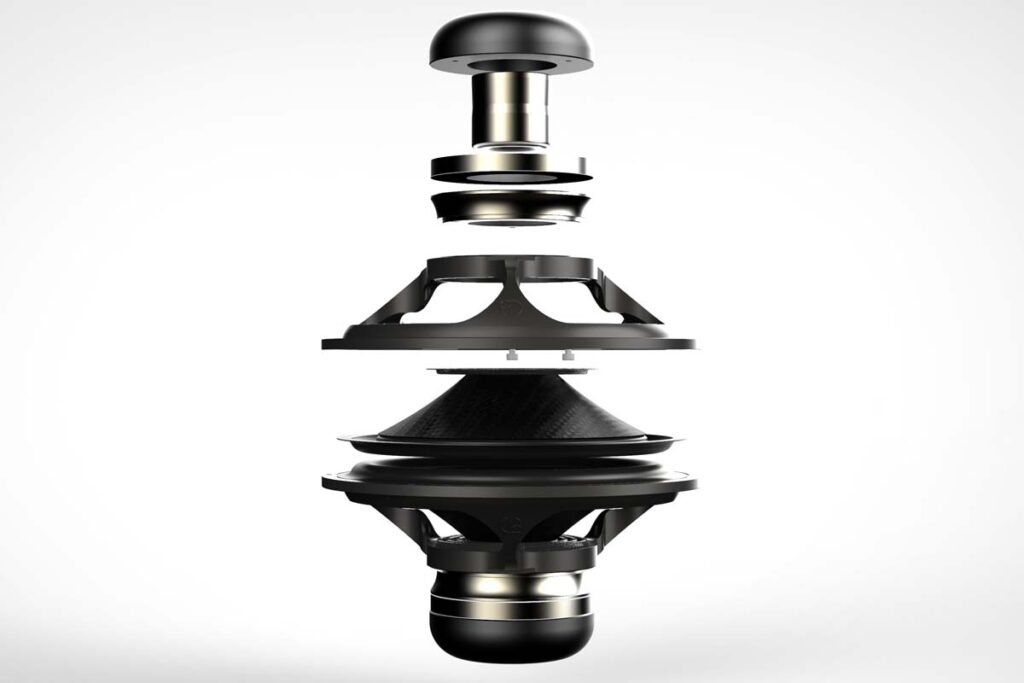
And indeed, after just a few days I began to notice that a slight scratchiness in the upper mids had diminished. One of those faint artifacts you automatically blame on the recording – something I never would have noticed on its own. But once I became aware of it, I could practically watch in slow motion as the midrange drivers became smoother, silkier, and more natural each day.
So let’s leave the otherworldly sonic realm for a moment and examine the Omnium simply as a technical object. As dry as that transition sounds – this is where things become really interesting.
When Craig Milnes founded Wilson Benesch with his wife Christina back in 1989, he brought not only a passion for audiophile sound but also a researcher’s instinct that commands respect: when he wants to understand something, he evidently doesn’t stop until he’s hit 120 percent. He began with innovative turntables, but soon set his sights on loudspeakers. The foundation of today’s Fibonacci series was laid by the Odyssey family, introduced in 2001. Earlier models like the Cardinal had already established the sleek, distinctive look of today’s designs, but it was the Odyssey Chimera – with its visually striking isobaric bass arrays – that provided the final puzzle piece. Everything that followed were refinements and additions built on the principles of their predecessors, which is reflected in our review model’s name: the Latin “Omnium” means “everything.” As the family’s second-largest speaker, it honors the fact that the Fibonacci series consolidates the collective knowledge of its ancestors. And if you’re wondering why the Omnium and Eminence – unlike other Fibonaccis – don’t carry the “3zero” suffix: those two largest models are new additions, so the suffix would be pointless without direct predecessors.

A central component of the latest conceptual refinements is Wilson Benesch’s participation in the SSUCHY research and development project. Initiated by the EU and supported by several universities, the project focuses (in simple terms) on deepening and optimizing knowledge of new materials and composites. During a visit to the AMCR (Advanced Manufacturing Research Centre), we watched Rolls-Royce engineers discuss the structural integrity of jet engines in one area of the massive facility, while right next to them students were doing comparatively menial sartorial work on carbon fabrics, testing the possibilities and limits of these materials. The woven fabrics came from an enormous loom capable of producing complex patterns. Just loading this behemoth with carbon filaments takes weeks, we were told during our guided tour.
One of the materials from that incredible machine appears in the Fibonaccis: like its siblings, the Omnium carries a carbon top shell that diffuses soundwaves hitting its surface into the listening room, contributing warmly to spatial acoustics. Made from a multilayer, moldable carbon textile, these shells can be formed seamlessly – without creases, seams, or cuts – and then cured. The only downside: a single roll of this miracle material costs Wilson Benesch about as much as a well-equipped compact car.
Wilson Benesch’s contributions to the SSUCHY mandate aren’t carried out at the AMCR but directly at their own facility northwest of Sheffield. From machining all aluminum components to manufacturing every driver and producing the composite side panels, Wilson Benesch has, over decades, mastered every segment of production. 120 percent! An Omnium is built entirely in-house. One of SSUCHY’s requirements is sustainability, both ecological and economic: materials used once should be recoverable and remain in circulation. The side walls, for example, consist of a composite of ultralight carbon mats, cork, and a flax-based fabric layer. These are bonded under high pressure with an epoxy resin. Early on, this process caused significant problems due to recurring air pockets. After experimenting with different methods, pressures, and temperatures, they found a way to stabilize production. Craig Milnes shares exactly these sorts of details with the AMCR and receives expert advice in return – an international exchange of knowledge.
A completely different challenge lies in the Omnium’s various drivers, also built in Sheffield. To keep the crossovers slim and phase-coherent, Craig Milnes developed an entire arsenal of 170-mm drivers optimized for specific frequency ranges – requiring minimal correction. Alongside carbon diaphragms of various thicknesses, each driver incorporates the namesake Fibonacci elements. In the midrange and bass drivers they serve as dustcaps; the 25-mm silk-dome tweeter sits in a frame featuring the distinctive arched shapes. If you’re wondering about this Fibonacci* business: the famous numerical sequence yields geometric forms found throughout nature (think sunflowers or seashells). These define the principles of the Golden Ratio and, when used as a structural element, provide exceptional stability and uniform force distribution. In the tweeter, the Fibonacci structure acts as an inertia damper and acoustic absorber. Wilson Benesch produces these delicate parts on an in-house phalanx of 3D printers.
The driver layout is fairly unusual. In the compact “head” section sit two “upper bass” units driven by Wilson Benesch’s powerful Tactic 3.0 motors. The main body houses the tweeter, a midrange, and three woofers – one tuned for low bass and the other two arranged as isobaric pairs with matching internal partners. If you’re unfamiliar with the principle: in Wilson Benesch’s “clamshell” configuration, the second, inward-facing driver is mounted directly behind the outer diaphragm. Since the two operate out of phase, they create a small chamber of constant pressure between them (Greek “isobar” – “equal pressure”). This decouples the radiating driver from cabinet-induced damping effects. From a measurement standpoint, the speaker effectively doubles its acoustic volume while minimizing distortion – highly advantageous for a slender form factor. And why doesn’t every speaker use this? Because it requires twice the number of drivers – and that costs money.
As the crowning touch, Wilson Benesch adds countless details that complement the speaker’s futuristic look while serving the sound. There’s the nearly 40-kg (90-lb) CNC-machined aluminum base. Its outriggers hold finely adjustable in-house spikes that sit in three steel balls in the supplied floor protectors, ensuring perfect stability. Under the base plate are four threaded points for attaching the included roll bars for easier movement. To prevent these from leaving marks or scratches on the underside of the cabinet (!), each point is cushioned with a small cork ring – that’s what we call “loving details.” The upper sections have hidden threaded inserts to attach lifting handles – also protected from scratches. The cable bridges between top and main cabinets are elegantly routed internally, though this requires special tools during assembly. Remember the bellows? The banana-capable bi-amping terminals use hex nuts that lock down spade connectors with ultra-firm contact. There are small recesses on the front for easy attachment of the included grilles. And, and, and… To sum it up: we don’t know of any other speaker family offering this degree of “DIY” and custom-made parts. Unless you’re staring at solder joints or the premium crossover components, nothing here comes off the shelf.
Which brings us back to the listening room – and to the question of what more can be said beyond the experiences already described. The fact is: the Omnium offers an exceptionally compelling bandwidth. It reproduces frequencies from 27 Hz to 30 kHz, delivering both volume and high resolution without favoring any part of the spectrum. Growling bass, sonorous vocals, shimmering highs: everything sits on a perfectly balanced seesaw. The phase and timing accuracy mentioned earlier delivers more than just coherence. When Nick Cave sings in his dark voice over the gently struck grand piano, the two sound sources blend into a single whole. Rarely have so many colleagues, after just a few minutes in the room, independently burst into praise for the speaker’s “perfect integration” of voices, guitars, strings, and everything else – a speaker you don’t listen to, but experience.
*Signor Fibonacci (1170–1240, Pisa) had demonstrably no knowledge of Wilson Benesch. Had you asked him between 9 and 11 p.m. in a medieval tavern about the sequence named after him or the Golden Ratio, he’d have given you a blank stare, then moved to another table. He studied the ancient sequence of natural numbers – each term being the sum of the previous two – to draw conclusions about rabbit-population growth. In recognition of his thorough documentation across several books, the sequence and some of its mathematical derivatives were named after him in the 19th century. Quite the feat – getting something named after you 650 years after your death…
Accompanying Equipment
Sources: Lumin P1 Mini, Audiodata MusikServer MS II, Audio Note (UK) CD3.1x | Preamplifier: Soulnote P-3 | Power Amplifiers: Soulnote M-3 and M-3x, Burmester 218 | Loudspeakers: Wilson Audio Sasha V, AdmiraVox AV 170 | Cables & Accessories: WestminsterLab, AudioQuest, beaudioful
Loudspeaker: Wilson Benesch Omnium
Concept: Passive floorstander with isobaric bass system and two-part cabinet | Driver complement: 2 × 170-mm upper-bass (Wilson Benesch Tactic 3.0), 1 × 170-mm midrange (Wilson Benesch Tactic 3.0), 1 × 170-mm woofer (Wilson Benesch Tactic 3.0), 4 × 170-mm isobaric system (Tactic 3.0, crossed at 500 Hz), 1 × tweeter (25-mm silk dome, from 5 kHz) | Impedance: 4.5 Ω | Sensitivity (2.83 V/1 m): 89 dB | Frequency response (±2 dB): 27 Hz–30 kHz | Terminals: Bi-wiring (banana and spade compatible) | Features: Fibonacci elements for damping/stabilizing mid and bass drivers; included transport rollers; flight cases; bottom-bass grilles; bellows tool for head/cable assembly; handles; spikes and floor protectors; German manual | Finishes: Black standard; 12 optional veneers, paints, and carbon trims; 3 optional finishes for bass motors (black, silver, gold) | Dimensions (W/H/D): 25 × 172 × 62 cm (without spikes/floor protectors) | Weight: 140 kg each (110 kg bass cabinet, 30 kg head cabinet) | Warranty period: 5 years | Price per pair: from 129 000 €


